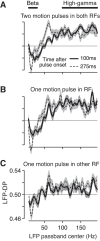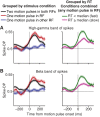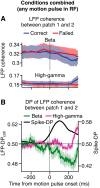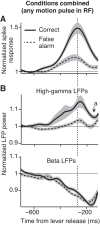Dynamics of the functional link between area MT LFPs and motion detection
- PMID: 25948867
- PMCID: PMC4507966
- DOI: 10.1152/jn.00058.2015
Dynamics of the functional link between area MT LFPs and motion detection
Abstract
The evolution of a visually guided perceptual decision results from multiple neural processes, and recent work suggests that signals with different neural origins are reflected in separate frequency bands of the cortical local field potential (LFP). Spike activity and LFPs in the middle temporal area (MT) have a functional link with the perception of motion stimuli (referred to as neural-behavioral correlation). To cast light on the different neural origins that underlie this functional link, we compared the temporal dynamics of the neural-behavioral correlations of MT spikes and LFPs. Wide-band activity was simultaneously recorded from two locations of MT from monkeys performing a threshold, two-stimuli, motion pulse detection task. Shortly after the motion pulse occurred, we found that high-gamma (100-200 Hz) LFPs had a fast, positive correlation with detection performance that was similar to that of the spike response. Beta (10-30 Hz) LFPs were negatively correlated with detection performance, but their dynamics were much slower, peaked late, and did not depend on stimulus configuration or reaction time. A late change in the correlation of all LFPs across the two recording electrodes suggests that a common input arrived at both MT locations prior to the behavioral response. Our results support a framework in which early high-gamma LFPs likely reflected fast, bottom-up, sensory processing that was causally linked to perception of the motion pulse. In comparison, late-arriving beta and high-gamma LFPs likely reflected slower, top-down, sources of neural-behavioral correlation that originated after the perception of the motion pulse.
Keywords: MT; behavior; cortex; local field potential; vision.
Copyright © 2015 the American Physiological Society.
Figures












Similar articles
-
The Magnitude, But Not the Sign, of MT Single-Trial Spike-Time Correlations Predicts Motion Detection Performance.J Neurosci. 2018 May 2;38(18):4399-4417. doi: 10.1523/JNEUROSCI.1182-17.2018. Epub 2018 Apr 6. J Neurosci. 2018. PMID: 29626168 Free PMC article.
-
Pattern motion selectivity of spiking outputs and local field potentials in macaque visual cortex.J Neurosci. 2009 Oct 28;29(43):13702-9. doi: 10.1523/JNEUROSCI.2844-09.2009. J Neurosci. 2009. PMID: 19864582 Free PMC article.
-
Low-frequency local field potentials and spikes in primary visual cortex convey independent visual information.J Neurosci. 2008 May 28;28(22):5696-709. doi: 10.1523/JNEUROSCI.0009-08.2008. J Neurosci. 2008. PMID: 18509031 Free PMC article.
-
The neuronal basis of motion perception.Ciba Found Symp. 1993;174:217-30; discussion 230-46. doi: 10.1002/9780470514412.ch11. Ciba Found Symp. 1993. PMID: 8319509 Review.
-
Local field potentials for BCI control.Handb Clin Neurol. 2020;168:279-288. doi: 10.1016/B978-0-444-63934-9.00020-2. Handb Clin Neurol. 2020. PMID: 32164859 Review.
Cited by
-
Differential Recovery of Submodality Touch Neurons and Interareal Communication in Sensory Input-Deprived Area 3b and S2 Cortices.J Neurosci. 2022 Dec 14;42(50):9330-9342. doi: 10.1523/JNEUROSCI.0034-22.2022. Epub 2022 Nov 15. J Neurosci. 2022. PMID: 36379707 Free PMC article.
-
Decision Signals in the Local Field Potentials of Early and Mid-Level Macaque Visual Cortex.Cereb Cortex. 2021 Jan 1;31(1):169-183. doi: 10.1093/cercor/bhaa218. Cereb Cortex. 2021. PMID: 32852540 Free PMC article.
-
Routing information flow by separate neural synchrony frequencies allows for "functionally labeled lines" in higher primate cortex.Proc Natl Acad Sci U S A. 2019 Jun 18;116(25):12506-12515. doi: 10.1073/pnas.1819827116. Epub 2019 May 30. Proc Natl Acad Sci U S A. 2019. PMID: 31147468 Free PMC article.
-
The Magnitude, But Not the Sign, of MT Single-Trial Spike-Time Correlations Predicts Motion Detection Performance.J Neurosci. 2018 May 2;38(18):4399-4417. doi: 10.1523/JNEUROSCI.1182-17.2018. Epub 2018 Apr 6. J Neurosci. 2018. PMID: 29626168 Free PMC article.
-
Coupled oscillations orchestrate selective information transmission in visual cortex.PNAS Nexus. 2024 Jul 31;3(8):pgae288. doi: 10.1093/pnasnexus/pgae288. eCollection 2024 Aug. PNAS Nexus. 2024. PMID: 39161729 Free PMC article.
References
-
- Ahmed B, Cordery PM, McLelland D, Bair W, Krug K. Long-range clustered connections within extrastriate visual area V5/MT of the rhesus macaque. Cereb Cortex 22: 60–73, 2012. - PubMed
-
- Asher I, Stark E, Abeles M, Prut Y. Comparison of direction and object selectivity of local field potentials and single units in macaque posterior parietal cortex during prehension. J Neurophysiol 97: 3684–3695, 2007. - PubMed
-
- Bastos AM, Vezoli J, Bosman CA, Schoffelen JM, Oostenveld R, Dowdall JR, De Weerd P, Kennedy H, Fries P. Visual areas exert feedforward and feedback influences through distinct frequency channels. Neuron 85: 390–401, 2015. - PubMed
Publication types
MeSH terms
Grants and funding
LinkOut - more resources
Full Text Sources
Other Literature Sources
Miscellaneous

